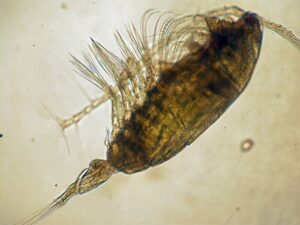A new study supported by NCCOS shows that the presence of zooplankton grazers dramatically increases toxin production in the marine dinoflagellate Alexandrium catenella, a species notorious for its paralytic shellfish toxin (PST) production, the cause of Paralytic Shellfish Poisoning in humans.
Dinoflagellate PST production is mediated by several abiotic and biotic factors. This study compared the relative importance of nitrogen source and concentration, prey (alga-to-alga) alarm cues and grazer presence on toxin production on A. catenella.

The study results showed that the addition of nitrogen in the form of ammonium or urea did not increase PST production. Interestingly, the presence of other Alexandrium species’ alga-to-alga alarm cues increased toxin production but not the presence of other A. catenella individuals. Grazer presence dramatically induced PST production in A. catenella, irrespective of nutrient conditions, and this effect was an order of magnitude greater than any of the other variables tested (see Figure 1). This implies that the observed increase in toxin production is indeed a response to the threat of grazers. Although nutrients are an important factor for bloom initiation and maintenance, grazing may be as important or more important of a factor in determining bloom toxicity.
These results corroborate previous studies on grazer-induced PST production, and support the hypothesis that grazer-induced toxin production is not an experimental artifact, but rather a prey defense mechanism. The results are important for NOAA-supported modeling and forecasting of Alexandrium (e.g., in the Gulf of Maine) where traditionally, grazing pressure was not considered a factor in bloom toxicity.

This study was supported by the NCCOS ECOHAB project “Are Growth and Toxicity of the Dinoflagellate Alexandrium Controlled by Grazer-Induced Defense?” led by Hans G. Dam, Professor of Marine Sciences at the University of Connecticut, Avery Point.

Citation: Griffin, Jessica E., Gihong Park, and Hans G. Dam. 2019. Relative importance of nitrogen sources, algal alarm cues and grazer exposure to toxin production of the marine dinoflagellate Alexandrium catenella. Harmful Algae 84: 181-187 https://doi.org/10.1016/j.hal.2019.04.006
